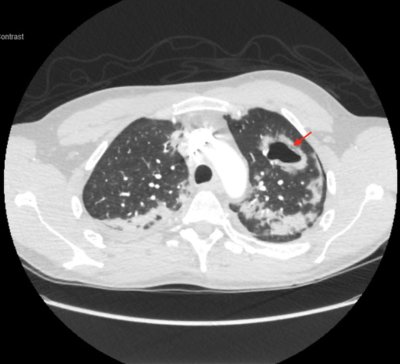A COVID-19 patient coughing up blood was found to have cavities in his lungs, according to his doctors.
The unnamed 52-year-old man visited Miriam Hospital in Providence, Rhode Island, three weeks after he was first diagnosed with COVID-19. He told doctors he had been coughing up blood, had an intermittent cough, and shortness of breath, according to a case study published in BMJ Case Reports. However, he didn't have a fever, which is a hallmark of COVID-19. A week before, he had been discharged after blood clots were found in a lung and leg.
An initial CT scan of the man's chest showed he had signs of pneumonia, a condition that is known to affect some COVID-19 patients. A later CT scan revealed the man had "cavitation" in his upper left lobe. Two weeks later, he visited the hospital after he kept coughing up blood and was suffering from shortness of breath. That time, CT scans revealed multiple new cavity lesions in both lungs, with the biggest in the left lower lobe.
Usually, such lesions are linked to bacterial, parasitic and fungal infections, autoimmune problems or growths but not COVID-19, according to the authors. Clinicians thought the man may have had tuberculosis or a fungal injection owing to the speed at which the multiple cavities developed in just a few weeks.
Consultants in infectious diseases, rheumatology and the respiratory system at the hospital recommended that the man have extensive testing to see if he had other infections aside from the COVID-19 coronavirus, such as autoimmune problems or HIV. But the tests came back negative. The man did, however, continue to test positive for the coronavirus.
Doctors gave the man antibiotics over the course of 14 days, and his symptoms started to improve. He was discharged and no longer coughs up blood.
The authors said it is unusual for COVID-19 patients with pneumonia to have lung cavitation. It is unclear what caused the case. However, past autopsy reports cited by the team suggest it could be due to damage to the tiny air sacs called alveoli hemorrhaging between these sacs, or the death of tissue that affects the organ.
As COVID-19 has only been a known disease for around six months, experts are still learning about how it manifests itself, the authors said. For instance, early- and late-stage complications linked with the disease are still largely unknown. Last month, a separate team of doctors reported the case of a man whose blood clots linked to COVID-19 are thought to have caused him to have an erection for four hours.
Moving forward, common causes of cavitary lung lesions should be investigated in all patients, the BMJ Case Reports authors said.


Uncommon Knowledge
Newsweek is committed to challenging conventional wisdom and finding connections in the search for common ground.
Newsweek is committed to challenging conventional wisdom and finding connections in the search for common ground.
About the writer
Kashmira Gander is Deputy Science Editor at Newsweek. Her interests include health, gender, LGBTQIA+ issues, human rights, subcultures, music, and lifestyle. Her ... Read more





